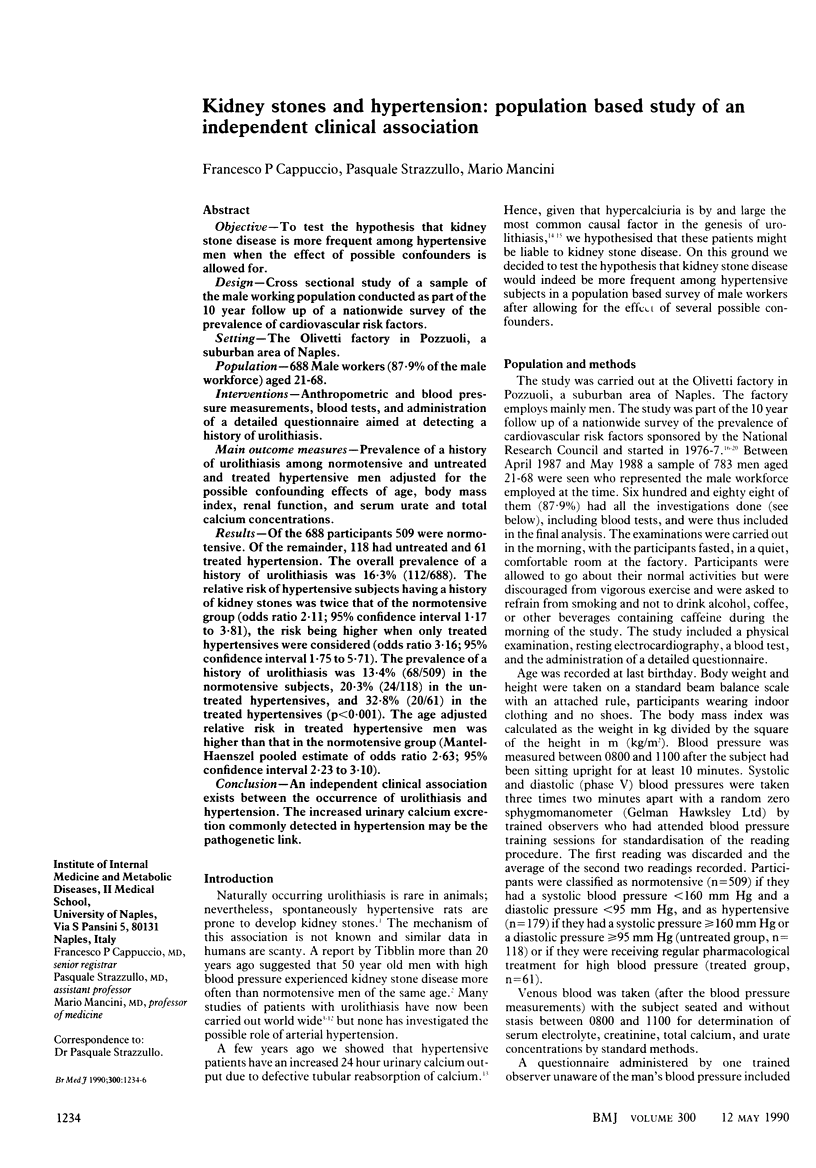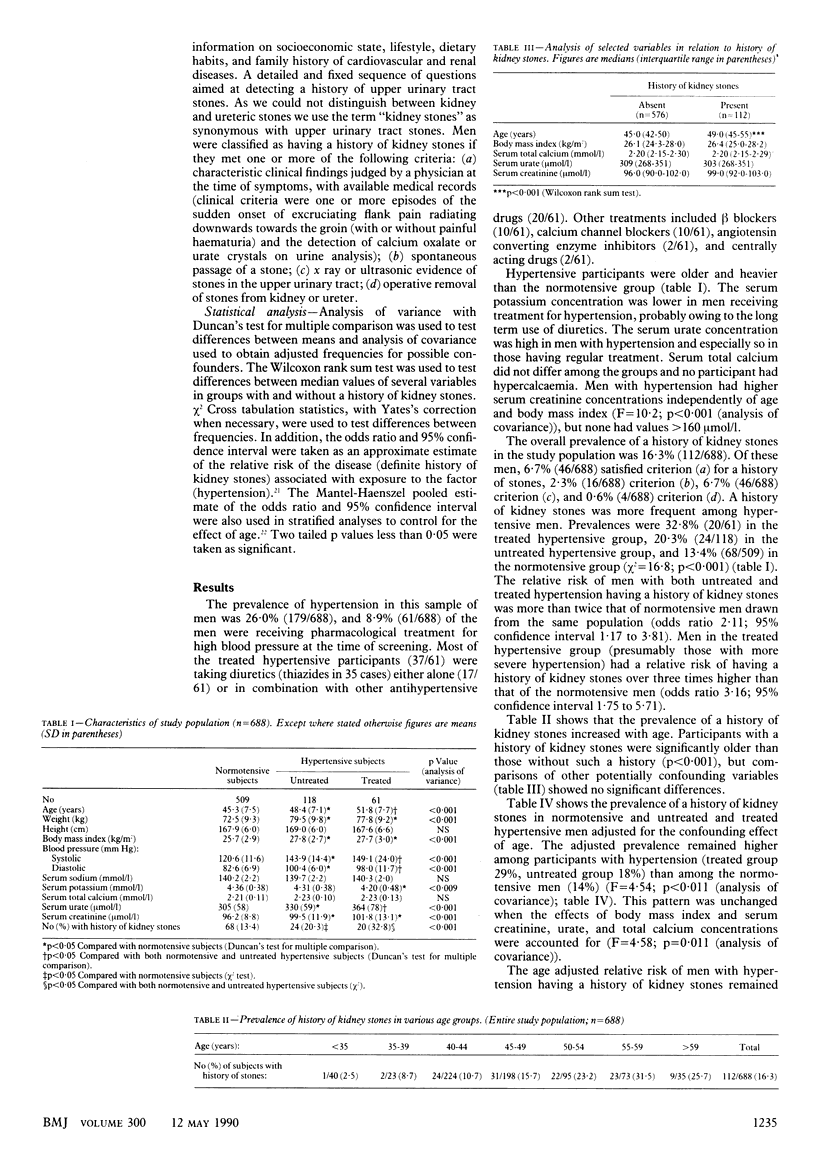Abstract
OBJECTIVE--To test the hypothesis that kidney stone disease is more frequent among hypertensive men when the effect of possible confounders is allowed for. DESIGN--Cross sectional study of a sample of the male working population conducted as part of the 10 year follow up of a nationwide survey of the prevalence of cardiovascular risk factors. SETTING--The Olivetti factory in Pozzuoli, a suburban area of Naples. POPULATION--688 Male workers (87.9% of the male workforce) aged 21-68. INTERVENTIONS--Anthropometric and blood pressure measurements, blood tests, and administration of a detailed questionnaire aimed at detecting a history of urolithiasis. MAIN OUTCOME MEASURES--Prevalence of a history of urolithiasis among normotensive and untreated and treated hypertensive men adjusted for the possible confounding effects of age, body mass index, renal function, and serum urate and total calcium concentrations. RESULTS--Of the 688 participants 509 were normotensive. Of the remainder, 118 had untreated and 61 treated hypertension. The overall prevalence of a history of urolithiasis was 16.3% (112/688). The relative risk of hypertensive subjects having a history of kidney stones was twice that of the normotensive group (odds ratio 2.11; 95% confidence interval 1.17 to 3.81), the risk being higher when only treated hypertensives were considered (odds ratio 3.16; 95% confidence interval 1.75 to 5.71). The prevalence of a history of urolithiasis was 13.4% (68/509) in the normotensive subjects, 20.3% (24/118) in the untreated hypertensives, and 32.8% (20/61) in the treated hypertensives (p less than 0.001). The age adjusted relative risk in treated hypertensive men was higher than that in the normotensive group (Mantel-Haenszel pooled estimate of odds ratio 2.63; 95% confidence interval 2.23 to 3.10). CONCLUSION--An independent clinical association exists between the occurrence of urolithiasis and hypertension. The increased urinary calcium excretion commonly detected in hypertension may be the pathogenetic link.
Full text
PDF


Selected References
These references are in PubMed. This may not be the complete list of references from this article.
- Bengtsson C., Lennartsson J., Lindquist O., Noppa H. Renal stone disease--experience from a population study of women in Gothenburg, Sweden. Scand J Urol Nephrol Suppl. 1980;53:39–43. [PubMed] [Google Scholar]
- Breckenridge A. Hypertension and hyperuricaemia. Lancet. 1966 Jan 1;1(7427):15–18. doi: 10.1016/s0140-6736(66)90005-5. [DOI] [PubMed] [Google Scholar]
- Churchill D. N., Maloney C. M., Bear J., Bryant D. G., Fodor G., Gault M. H. Urolithiasis--a study of drinking water hardness and genetic factors. J Chronic Dis. 1980;33(11-12):727–731. doi: 10.1016/0021-9681(80)90060-0. [DOI] [PubMed] [Google Scholar]
- Cirillo M., Siani A., Nunziata V., Cappuccio F. P., Mattioli P. L., Strazzullo P. Ridotto rapporto Mg/Ca nelle urine e rischio di nefrolitiasi nell'ipertensione essenziale. Minerva Nefrol. 1983 Oct-Dec;30(4):213–216. [PubMed] [Google Scholar]
- Currie W. J., Turmer P. The frequency of renal stones within Great Britain in a gouty and non-gouty population. Br J Urol. 1979 Oct;51(5):337–341. doi: 10.1111/j.1464-410x.1979.tb02880.x. [DOI] [PubMed] [Google Scholar]
- DOLLERY C. T., DUNCAN H., SCHUMER B. Hyperuricaemia related to treatment of hypertension. Br Med J. 1960 Sep 17;2(5202):832–835. doi: 10.1136/bmj.2.5202.832. [DOI] [PMC free article] [PubMed] [Google Scholar]
- Hiatt R. A., Dales L. G., Friedman G. D., Hunkeler E. M. Frequency of urolithiasis in a prepaid medical care program. Am J Epidemiol. 1982 Feb;115(2):255–265. doi: 10.1093/oxfordjournals.aje.a113297. [DOI] [PubMed] [Google Scholar]
- Johnson C. M., Wilson D. M., O'Fallon W. M., Malek R. S., Kurland L. T. Renal stone epidemiology: a 25-year study in Rochester, Minnesota. Kidney Int. 1979 Nov;16(5):624–631. doi: 10.1038/ki.1979.173. [DOI] [PubMed] [Google Scholar]
- Lewis B., Chait A., Sigurdsson G. Serum lipoprotiens in four European communities: a quantitative comparison. Eur J Clin Invest. 1978 Jun;8(3):165–173. doi: 10.1111/j.1365-2362.1978.tb00830.x. [DOI] [PubMed] [Google Scholar]
- Ljunghall S., Hedstrand H. Epidemiology of renal stones in a middle-aged male population. Acta Med Scand. 1975 Jun;197(6):439–445. doi: 10.1111/j.0954-6820.1975.tb04948.x. [DOI] [PubMed] [Google Scholar]
- McCarron D. A., Pingree P. A., Rubin R. J., Gaucher S. M., Molitch M., Krutzik S. Enhanced parathyroid function in essential hypertension: a homeostatic response to a urinary calcium leak. Hypertension. 1980 Mar-Apr;2(2):162–168. doi: 10.1161/01.hyp.2.2.162. [DOI] [PubMed] [Google Scholar]
- Morris J. A., Gardner M. J. Calculating confidence intervals for relative risks (odds ratios) and standardised ratios and rates. Br Med J (Clin Res Ed) 1988 May 7;296(6632):1313–1316. doi: 10.1136/bmj.296.6632.1313. [DOI] [PMC free article] [PubMed] [Google Scholar]
- Robertson W. G., Peacock M., Baker M., Marshall D. H., Pearlman B., Speed R., Sergeant V., Smith A. Studies on the prevalence and epidemiology of urinary stone disease in men in Leeds. Br J Urol. 1983 Dec;55(6):595–598. doi: 10.1111/j.1464-410x.1983.tb03383.x. [DOI] [PubMed] [Google Scholar]
- Strazzullo P., Cappuccio F. P., Trevisan M., Iacoviello L., Iacone R., Barba G., De Leo A., Farinaro E., Mancini M. Red blood cell sodium-lithium countertransport, blood pressure, and uric acid metabolism in untreated healthy men. Am J Hypertens. 1989 Aug;2(8):634–636. doi: 10.1093/ajh/2.8.634. [DOI] [PubMed] [Google Scholar]
- Strazzullo P., Nunziata V., Cirillo M., Giannattasio R., Ferrara L. A., Mattioli P. L., Mancini M. Abnormalities of calcium metabolism in essential hypertension. Clin Sci (Lond) 1983 Aug;65(2):137–141. doi: 10.1042/cs0650137. [DOI] [PubMed] [Google Scholar]
- Strazzullo P., Trevisan M., Farinaro E., Cappuccio F. P., Ferrara L. A., de Campora E., Mancini M. Characteristics of the association between salt intake and blood pressure in a sample of male working population in southern Italy. Eur Heart J. 1983 Sep;4(9):608–613. doi: 10.1093/oxfordjournals.eurheartj.a061532. [DOI] [PubMed] [Google Scholar]
- Vahlensieck E. W., Bach D., Hesse A. Incidence, Prevalence and mortality of urolithiasis in the German Federal Republic. Urol Res. 1982;10(4):161–164. doi: 10.1007/BF00255937. [DOI] [PubMed] [Google Scholar]
- Wexler B. C., McMurtry J. P. Kidney and bladder calculi in spontaneously hypertensive rats. Br J Exp Pathol. 1981 Aug;62(4):369–374. [PMC free article] [PubMed] [Google Scholar]


